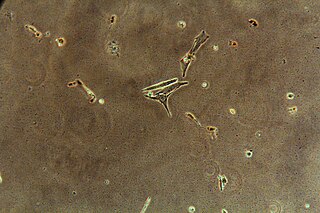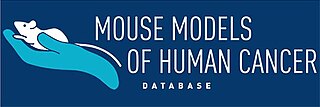Related Research Articles
Autocrine signaling is a form of cell signaling in which a cell secretes a hormone or chemical messenger that binds to autocrine receptors on that same cell, leading to changes in the cell. This can be contrasted with paracrine signaling, intracrine signaling, or classical endocrine signaling.
Mouse mammary tumor virus (MMTV) is a milk-transmitted retrovirus like the HTL viruses, HI viruses, and BLV. It belongs to the genus Betaretrovirus. MMTV was formerly known as Bittner virus, and previously the "milk factor", referring to the extra-chromosomal vertical transmission of murine breast cancer by adoptive nursing, demonstrated in 1936, by John Joseph Bittner while working at the Jackson Laboratory in Bar Harbor, Maine. Bittner established the theory that a cancerous agent, or "milk factor", could be transmitted by cancerous mothers to young mice from a virus in their mother's milk. The majority of mammary tumors in mice are caused by mouse mammary tumor virus.

FOXP3, also known as scurfin, is a protein involved in immune system responses. A member of the FOX protein family, FOXP3 appears to function as a master regulator of the regulatory pathway in the development and function of regulatory T cells. Regulatory T cells generally turn the immune response down. In cancer, an excess of regulatory T cell activity can prevent the immune system from destroying cancer cells. In autoimmune disease, a deficiency of regulatory T cell activity can allow other autoimmune cells to attack the body's own tissues.

A mammary tumor is a neoplasm originating in the mammary gland. It is a common finding in older female dogs and cats that are not spayed, but they are found in other animals as well. The mammary glands in dogs and cats are associated with their nipples and extend from the underside of the chest to the groin on both sides of the midline. There are many differences between mammary tumors in animals and breast cancer in humans, including tumor type, malignancy, and treatment options. The prevalence in dogs is about three times that of women. In dogs, mammary tumors are the second most common tumor over all and the most common tumor in female dogs with a reported incidence of 3.4%. Multiple studies have documented that spaying female dogs when young greatly decreases their risk of developing mammary neoplasia when aged. Compared with female dogs left intact, those spayed before puberty have 0.5% of the risk, those spayed after one estrous cycle have 8.0% of the risk, and dogs spayed after two estrous cycles have 26.0% of the risk of developing mammary neoplasia later in life. Overall, unspayed female dogs have a seven times greater risk of developing mammary neoplasia than do those that are spayed. While the benefit of spaying decreases with each estrous cycle, some benefit has been demonstrated in female dogs even up to 9 years of age. There is a much lower risk in male dogs and a risk in cats about half that of dogs.

INT-2 proto-oncogene protein also known as FGF-3 is a protein that in humans is encoded by the FGF3 gene.
Env is a viral gene that encodes the protein forming the viral envelope. The expression of the env gene enables retroviruses to target and attach to specific cell types, and to infiltrate the target cell membrane.

Syndecan 1 is a protein which in humans is encoded by the SDC1 gene. The protein is a transmembrane heparan sulfate proteoglycan and is a member of the syndecan proteoglycan family. The syndecan-1 protein functions as an integral membrane protein and participates in cell proliferation, cell migration and cell-matrix interactions via its receptor for extracellular matrix proteins. Syndecan-1 is a sponge for growth factors and chemokines, with binding largely via heparan sulfate chains. The syndecans mediate cell binding, cell signaling, and cytoskeletal organization and syndecan receptors are required for internalization of the HIV-1 tat protein.
Interleukin 35 (IL-35) is a recently discovered anti-inflammatory cytokine from the IL-12 family. Member of IL-12 family - IL-35 is produced by wide range of regulatory lymphocytes and plays a role in immune suppression. IL-35 can block the development of Th1 and Th17 cells by limiting early T cell proliferation.
An oncoantigen is a surface or soluble tumor antigen that supports tumor growth. A major problem of cancer immunotherapy is the selection of tumor cell variants that escape immune recognition. The notion of oncoantigen was set forth in the context of cancer immunoprevention to define a class of persistent tumor antigens not prone to escape from immune recognition.

GATA3 is a transcription factor that in humans is encoded by the GATA3 gene. Studies in animal models and humans indicate that it controls the expression of a wide range of biologically and clinically important genes.

Single-minded homolog 2 is a protein that in humans is encoded by the SIM2 gene. It plays a major role in the development of the central nervous system midline as well as the construction of the face and head.

Metastasis-associated protein MTA3 is a protein that in humans is encoded by the MTA3 gene. MTA3 protein localizes in the nucleus as well as in other cellular compartments MTA3 is a component of the nucleosome remodeling and deacetylate (NuRD) complex and participates in gene expression. The expression pattern of MTA3 is opposite to that of MTA1 and MTA2 during mammary gland tumorigenesis. However, MTA3 is also overexpressed in a variety of human cancers.

Zinc finger protein Helios is a protein that in humans is encoded by the IKZF2 gene. This protein is a member of Ikaros family of transcription factors.
Cancer immunoprevention is the prevention of cancer onset with immunological means such as vaccines, immunostimulators or antibodies. Cancer immunoprevention is conceptually different from cancer immunotherapy, which aims at stimulating immunity in patients only after tumor onset, however the same immunological means can be used both in immunoprevention and in immunotherapy.
Mouse models of colorectal cancer and intestinal cancer are experimental systems in which mice are genetically manipulated, fed a modified diet, or challenged with chemicals to develop malignancies in the gastrointestinal tract. These models enable researchers to study the onset, progression of the disease, and understand in depth the molecular events that contribute to the development and spread of colorectal cancer. They also provide a valuable biological system, to simulate human physiological conditions, suitable for testing therapeutics.
The S100 calcium-binding protein mS100a7a15 is the murine ortholog of human S100A7 (Psoriasin) and human S100A15 (Koebnerisin). mS100a7a15 is also known as S100a15, mS100a7 and mS100a7a and is encoded by the mS100a7a gene
Breast cancer metastatic mouse models are experimental approaches in which mice are genetically manipulated to develop a mammary tumor leading to distant focal lesions of mammary epithelium created by metastasis. Mammary cancers in mice can be caused by genetic mutations that have been identified in human cancer. This means models can be generated based upon molecular lesions consistent with the human disease.

B16 melanoma is a murine tumor cell line used for research as a model for human skin cancers. B16 cells are useful models for the study of metastasis and solid tumor formation, and were one of the first effective murine tools for metastasis research.

4T1 is a breast cancer cell line derived from the mammary gland tissue of a mouse BALB/c strain. 4T1 cells are epithelial and are resistant to 6-thioguanine. In preclinical research, 4T1 cells have been used to study breast cancer metastasis as they can metastasize to the lung, liver, lymph nodes, brain and bone. The cells are known to be highly aggressive in live tissues.

The laboratory mouse has been instrumental in investigating the genetics of human disease, including cancer, for over 110 years. The laboratory mouse has physiology and genetic characteristics very similar to humans providing powerful models for investigation of the genetic characteristics of disease.
References
- ↑ Nanni P, C De Giovanni, P-L Lollini, G Nicoletti, and G Prodi. 1983. "TS/A: a new metastasizing cell line from a BALB/c spontaneous mammary adenocarcinoma". Clinical and Experimental Metastasis. 1(4): 373-80.
- ↑ De Giovanni C, Nicoletti G, Landuzzi L, Palladini A, Lollini PL, Nanni P. "Bioprofiling TS/A Murine Mammary Cancer for a Functional Precision Experimental Model". Cancers (Basel). 2019 Nov 27;11(12).
- ↑ Allione A, M Consalvo, P Nanni, P-L Lollini, F Cavallo, M Giovarelli, M Forni, A Gulino, MP Colombo, P Dellabona, H Hock, T Blankenstein, FM Rosenthal, B Gansbacher, MC Bosco, T Musso, L Gusella, and Guido Forni. 1994. "Immunizing and curative potential of replicating and nonreplicating murine mammary adenocarcinoma cells engineered with interleukin (IL)-2, IL-4, IL-6, IL-7, IL-10, tumor necrosis factor alpha, granulocyte-macrophage colony-stimulating factor, and gamma-interferon gene or admixed with conventional adjuvants". Cancer Research. 54(23): 6022-6026.